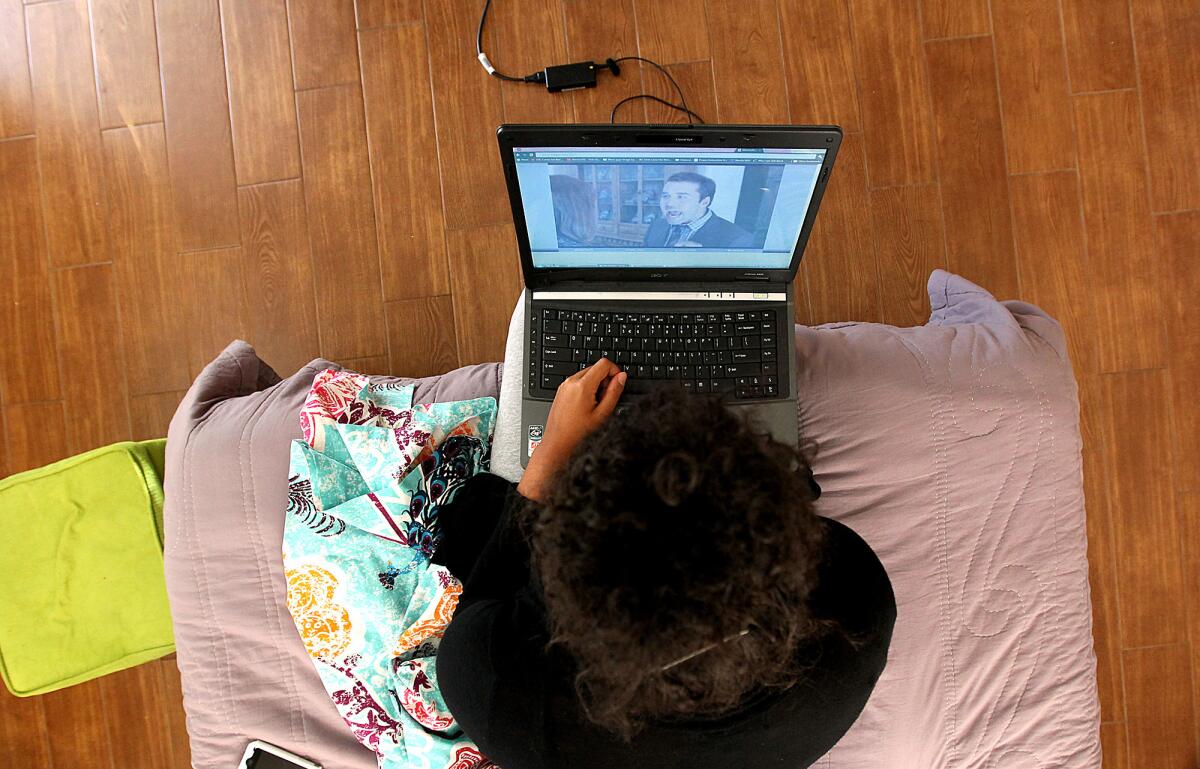Opinion: ‘Six strikes’ program shows promise, with caveats

- Share via
A little more than a year ago, the major music and movie companies got a version of the anti-piracy tool they’d long coveted: a system that automatically warned broadband subscribers when their accounts had been used for unauthorized file-sharing. Judging by the results from its first 10 months in operation, it may take little more than a warning to stop the vast majority of illegal downloads.
Whether it stops illegal streams is a whole ‘nother question.
The warnings come from the Copyright Alert System, which is operated by a coalition of entertainment companies and Internet service providers called the Center for Copyright Information. It works like this: Record companies and movie studios monitor peer-to-peer networks (typically with the help of an anti-piracy contractor) for unauthorized downloads of their works.
When they spot infringing activity by another user, they determine the user’s IP address and notify the ISP that assigned the address. If the ISP verifies that the address was assigned to one of its customers, it sends an alert to that customer that the account had been used for an unauthorized download, identifying when it happened and the title of the song or movie involved.
In a report issued Wednesday, the Center for Copyright Information said the system sent more than 2 million notices to ISPs during the 10 months it was in operation last year, and ISPs sent alerts to about 723,000 customers. What’s interesting, though, is how few customers received multiple notices.
According to the center, more than half a million of those customers received only that first “educational” notice, which advised them of the steps they could take to stop infringements and the places they could go online to find legal sources of music and movies. About 50,000 additional customers received only one more educational notice; altogether, almost 80% of the people who received notices never made it past this level.
The third and fourth notices went a step further, requiring an ISP’s customer to acknowledge that they’d received the notice. About 100,000 accounts, or 13% of the total, fell into this category.
Finally, a little more than 60,000 accounts, or 8%, received fifth or sixth notices, which imposed some kind of penalty. Some ISPs imposed a temporary reduction in bandwidth; others temporarily redirected the customers’ browsers until they’d contacted the ISP or took an online course about copyrights.
The report covers less than a year of activity, and it’s possible that more of the accounts that received only one or two notices will be hit with more in the coming months. Also, the system was ramped up gradually, so it sent half as many notices to ISPs as it plans to do in 2014. But if the trend holds, it suggests that simply telling people that their accounts are being used for unauthorized file-sharing and pointing them to legal sources of music and movies is enough to stop the illegal downloads.
The entertainment industry had pushed for tougher measures with stiffer penalties for accounts that were used repeatedly for piracy, such as the “three strikes” system that the French government tried before shifting its focus to commercial piracy. The major U.S. ISPs have resisted such draconian measures, though, and if a warning-only regime proves effective in stopping piracy by mainstream Internet users, that could be the final nail in the three-strikes coffin.
The unanswered question, though, is whether the notices move people into authorized online services or simply away from file-sharing. There’s no lack of illicit services that stream songs, movies and TV shows for free, and the Copyright Alert System doesn’t monitor those -- at least not yet. “The goal is not to limit ourselves to p2p,” said Jill Lesser, the center’s director. “What we’re really after is helping people who are not getting content legitimately to find it in ways that are legitimate.”
But are users willing to go along? Most appear to be, according to a survey of Internet users that the center commissioned after launching the alert system.
Conducted by Ipsos, the survey found that an increasing number of Internet users were frequenting authorized outlets for music, TV and movies online -- in fact, a majority of users in the survey reported using such sources in the previous six months. Nearly 60% of respondents said they would stop infringing if they received an alert, and more than 60% said it was never appropriate to violate copyrights. However, about the same number said they were confused about how to tell which sources were legal.
That confusion is understandable, considering that the most popular peer-to-peer technology, the BitTorrent protocol, is being used for legal and illegal file sharing. The former camp includes a small but growing number of artists using BitTorrent Inc.’s Bundles program. There’s also the issue of unauthorized content getting uploaded to legal user-generated content sites, such as YouTube.
“You have to be able to educate people across the board that, first and foremost, an enormous amount of content that people are looking for is available in legitimate formats,” Lesser said. But she added, “One of the biggest problems is helping people weed through all of the various options and being able to say, ‘This site that very much looks like that site, this one’s legal that one’s not.’”
More to Read
A cure for the common opinion
Get thought-provoking perspectives with our weekly newsletter.
You may occasionally receive promotional content from the Los Angeles Times.







